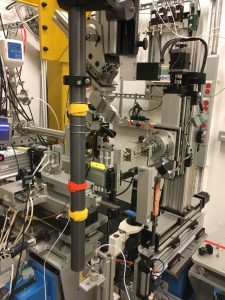- Diffraction-based analysis of materials structures

I am a veteran user in the usage of diffraction techniques. I was a participant in the National School on Neutron and X-ray Scattering hold by Argonne and Oak Ridge National Laboratory, and I have won the best proposal presentation. Laboratory X-ray diffraction is routinely carried out for the phase determination of materials. In addition, I have lead the use of neutron (POWGEN) and synchrotron (17-BMB, 6-BM) for my project. I am experienced with various software for Rietveld refinement of diffraction results (including Topas (GUI and launch mode), GSAS-II, XND, OLEX2, etc.), which are used for the quantitave phase analysis, structure refinement, as well as structure solution with both single crystal and powder data.
Selected publications:
CrystEngComm, 2019, 21, 2718.
Energy Storage Mater., 2019, 17, 151.
J. Mater. Chem. C, 2017, 5, 5709.
Chem. Mater., 2016, 28, 3080
- In situ diffraction-based investigation of materials chemistry

In situ diffraction has been utilized for resolving reaction mechanisms so as to improve the design of materials synthesis. Examples include laboratory in situ high temperature diffraction for the understanding of the formation of ternary sulfide crystals and flux growth of new Ba-Fe-S phases. In addition, travel to national laboratory for more advanced studies are also often carried out. This include the high temperature diffraction (17-BM-B, Argonne) for in situ flux-based synthesis, and energy dispersive X-ray (6-BM, Argonne) and neutron diffraction (POWGEN, Oak Ridge) for in situ solvothermal reaction studies. Chemical reaction maps can be generated from these studies, which reveal critical steps of crystal formation. Knowledge of which can be used to improve materials chemistry practices.


Relevant publications:
Sol. Energy Mater. Sol. Cells, 2019, 190, 37.
J. Mater. Chem. C, 2017, 5, 5709.
- Spectroscopic characterization of material properties

I frequently perform materials characterization whenever needed. The integration of information obtained from a multitude of techniques conveys information on the identity of materials, reaction chemistry on the formation and transformation of materials, and structural features related to their performance. The techniques I have been exposed to includes various spectroscopy (Raman, UV-vis, FTIR, PL, XRF, XPS) and resonance (NMR, EPR) techniques. One highlight (shown above) is the use of micro-Raman spectroscopy to discern three copper oxide phases, therefore providing a link between chemical identity and microstructural features.
Selected publications:
CrystEngComm, 2019, 21, 2718.
Chem. Mater., 2016, 28, 3080.
J. Phys. Chem. C, 2013, 117, 14973.
Adv. Energy Mater., 2013, 3, 1368.
- Electron microscopic examination of materials

SEM and TEM are frequently used, both for imaging and analysis of materials. The crystal shape, microstructure, nanostructure, and structural relations among different phases are important to the reaction chemistry as well as the properties and performance of the materials. I am a veteran user of SEM for imaging and EDS, with some exposure to TEM and EBSD in SEM.
Selected publications:
J. Solid State Chem., 2018, 260, 1.
J. Mater. Chem. C, 2017, 5, 5709.
Chem. Mater., 2016, 28, 3080.
Adv. Energy Mater., 2013, 3, 1368.
Adv. Funct. Mater., 2013, 23, 2932.
- Magnetic, physical and electrochemical measurement of materials

It is very important to realize the various aspects of materials properties, which I am very involved. Examples of these activities include: MPMS, PPMS, thermo-physical measurement (TGA, DSC), electrochemical (CV, impedance spectroscopy) and various other techniques (e.g. gas adsorption/desorption).
Relevant publications:
CrystEngComm, 2019, 21, 2718.
J. Solid State Chem., 2018, 260, 1.
Chem. Mater., 2016, 28, 3080.
Adv. Energy Mater., 2013, 3, 1368.
Adv. Funct. Mater., 2013, 23, 2932.

